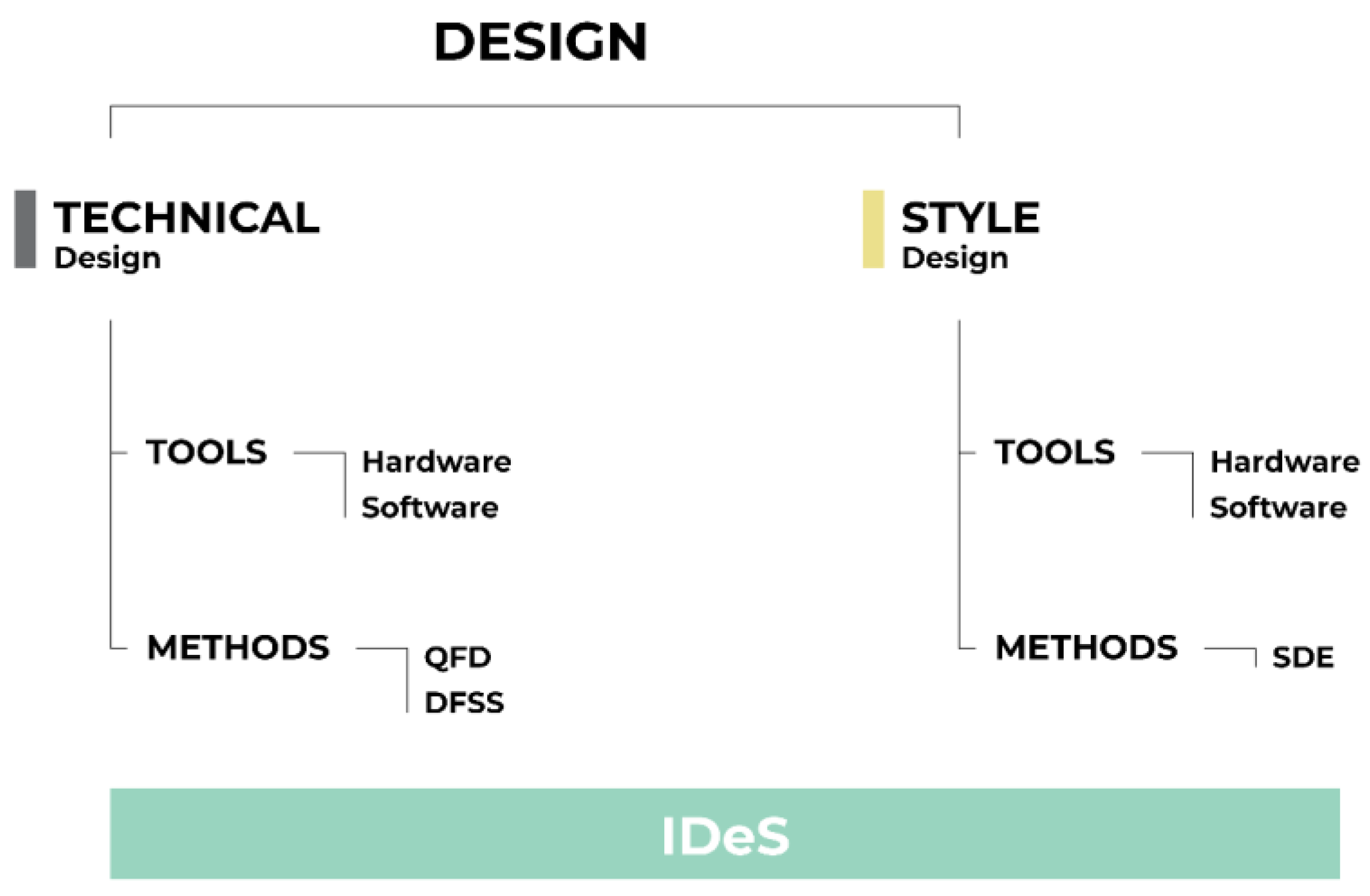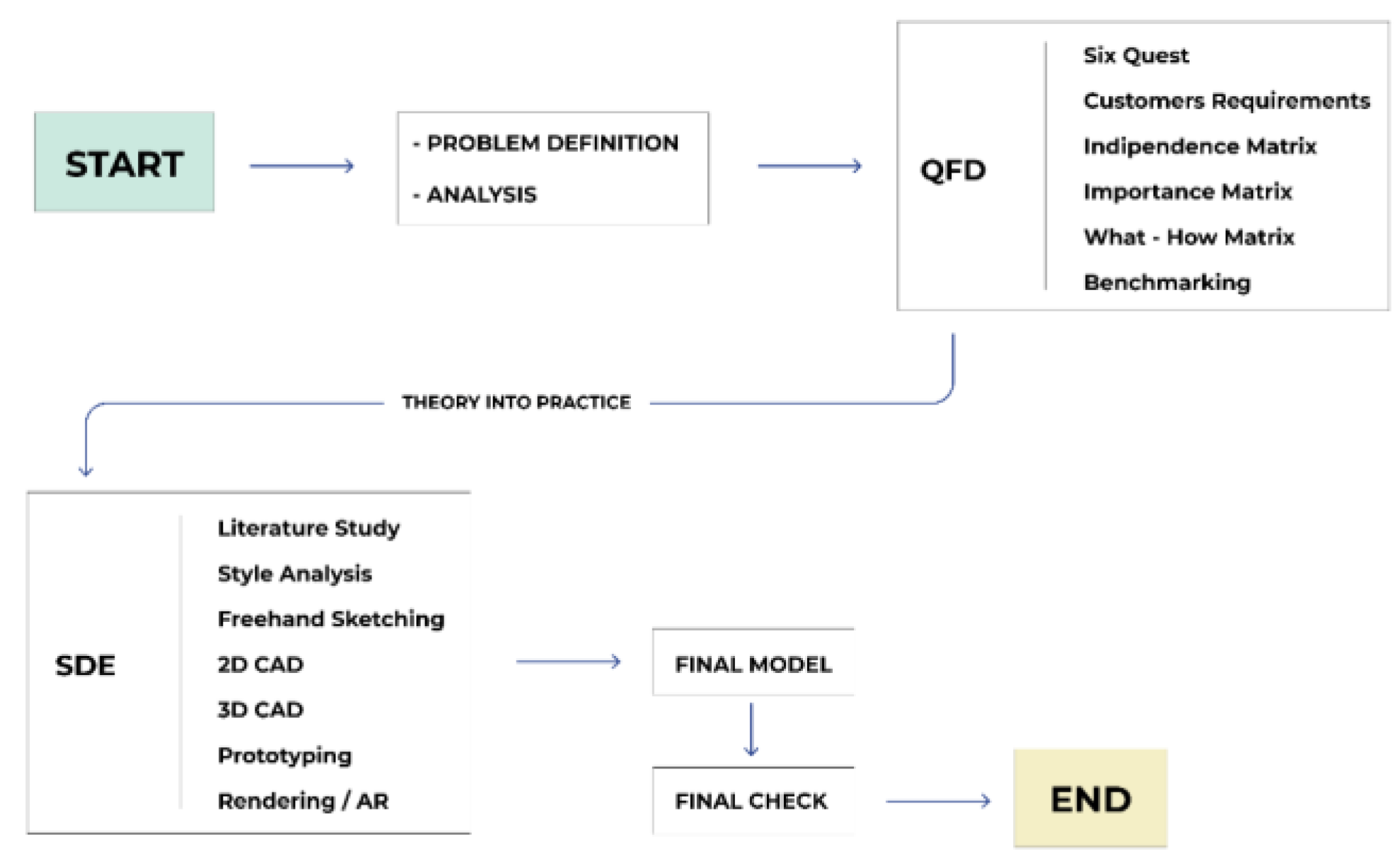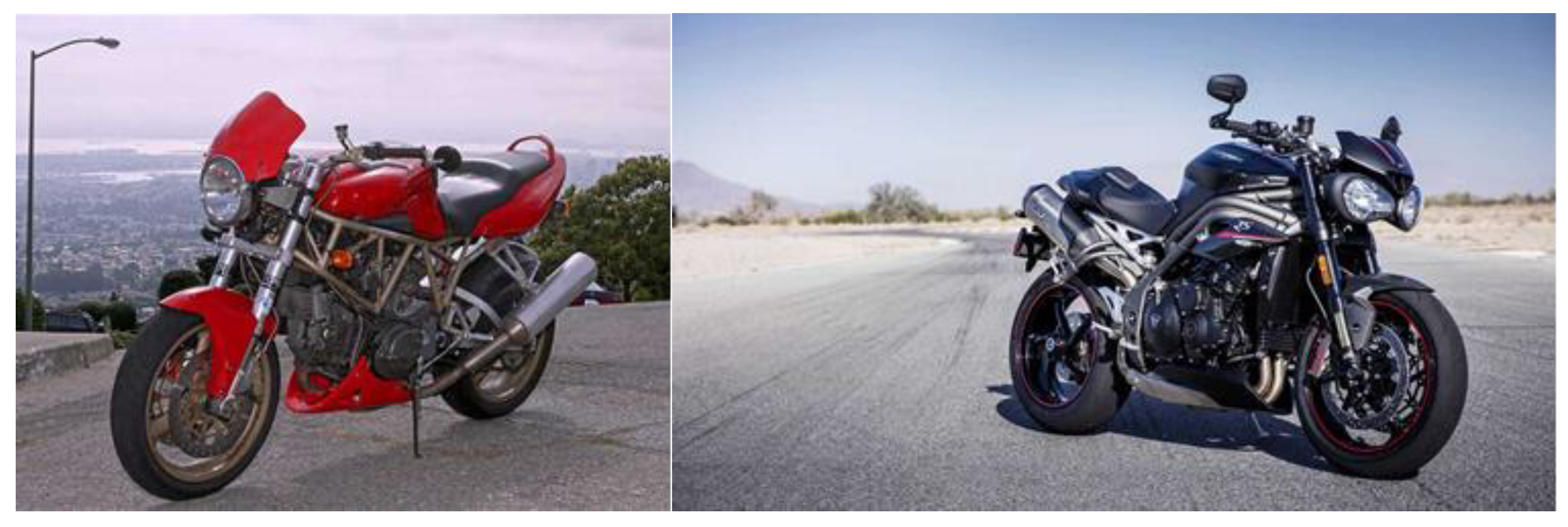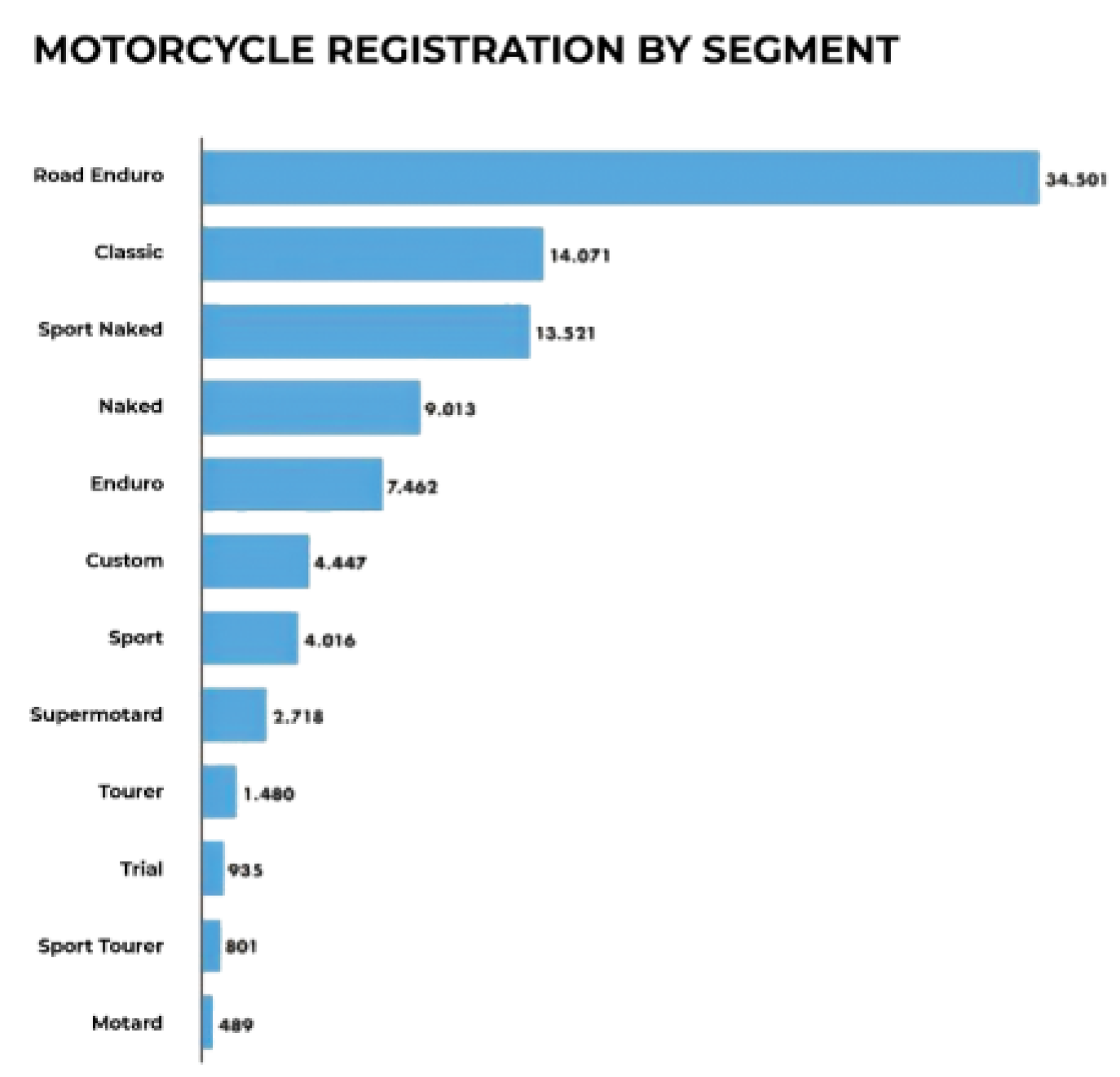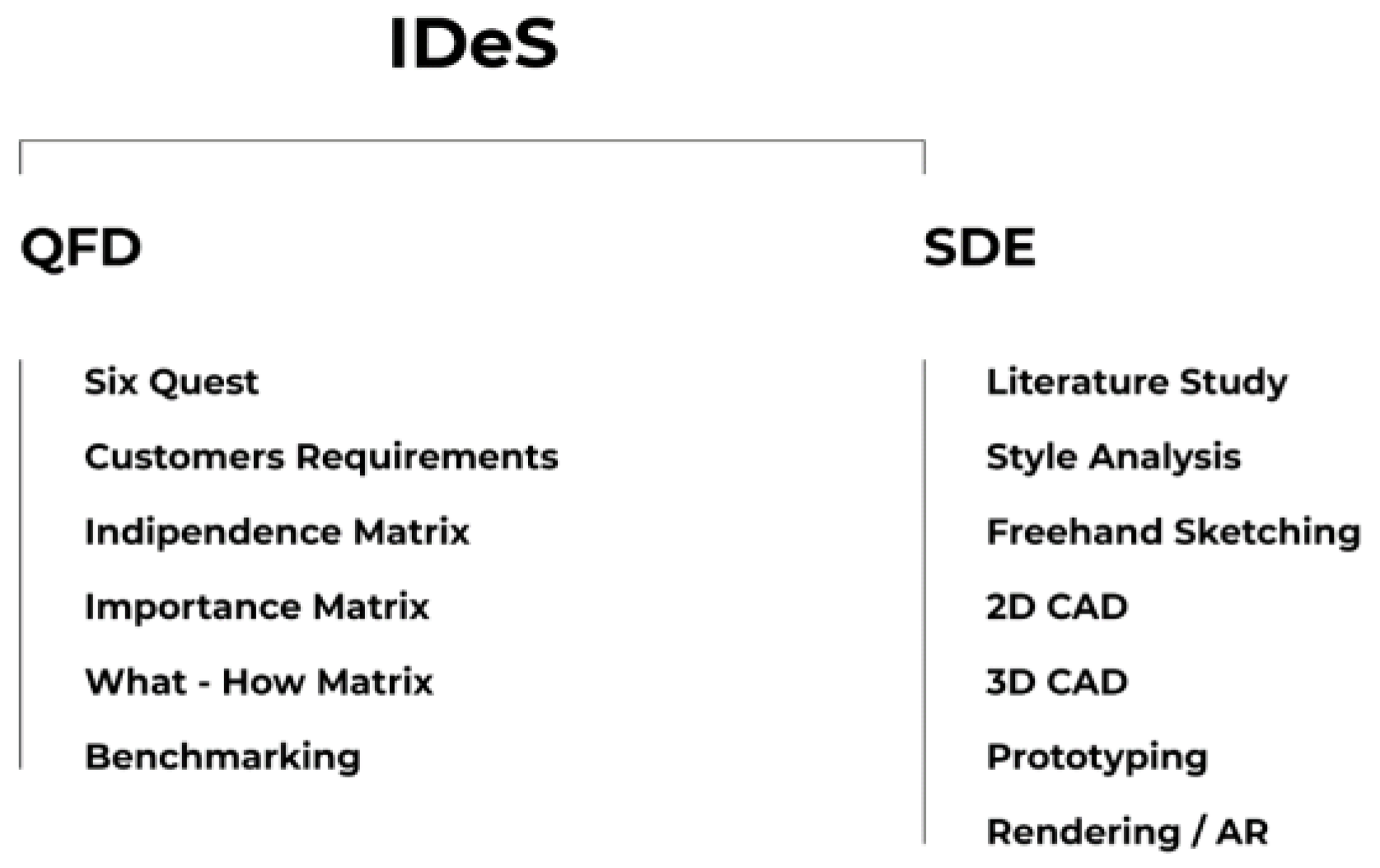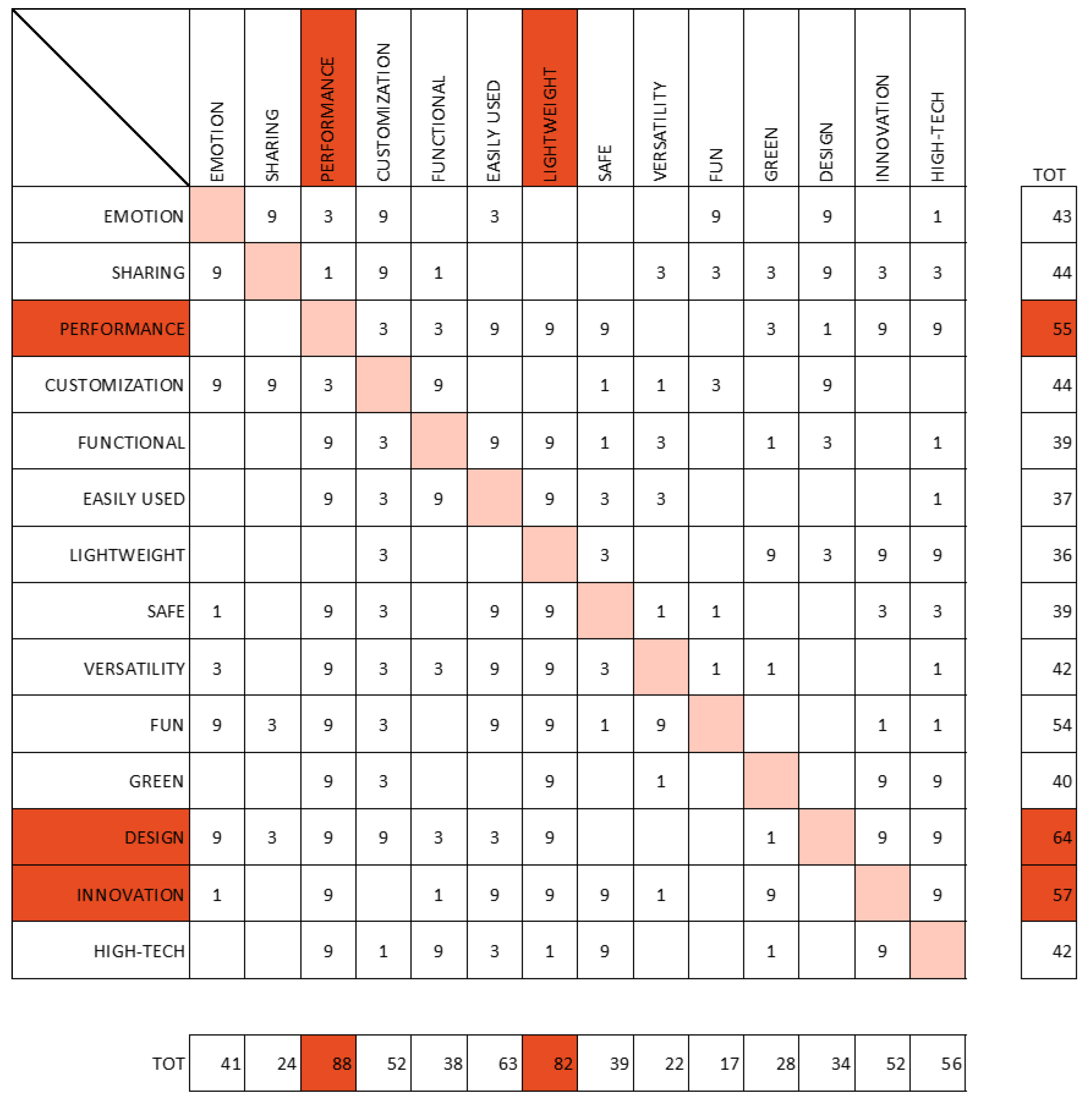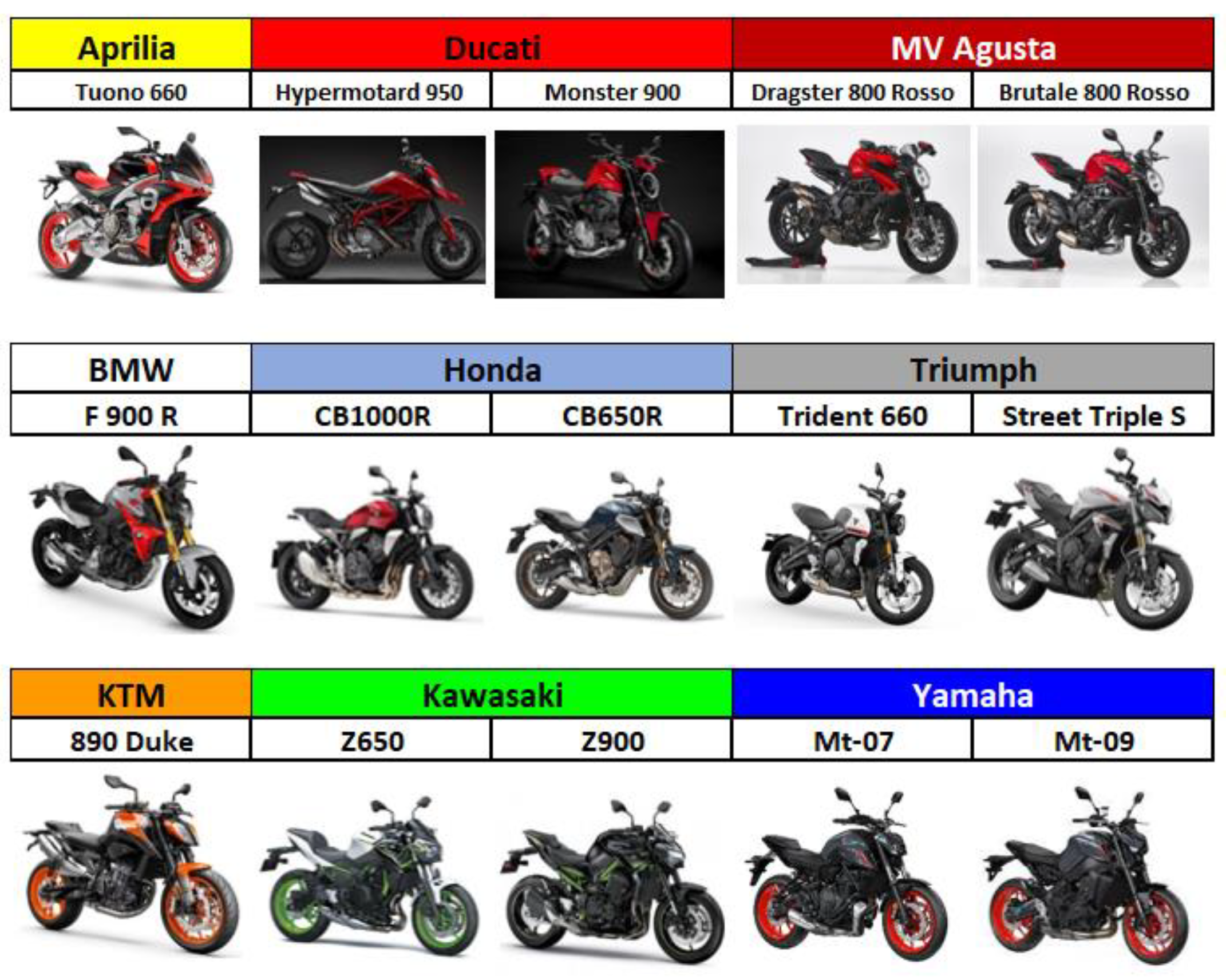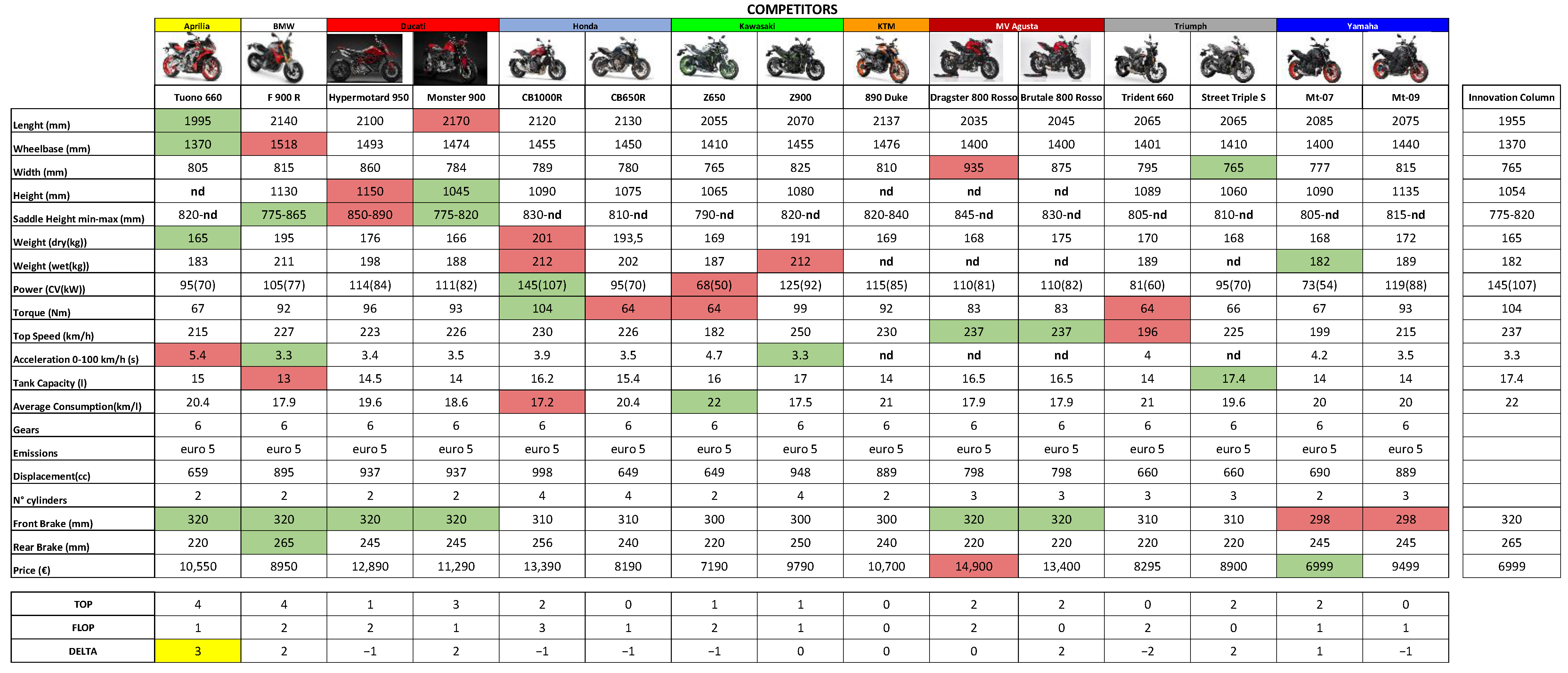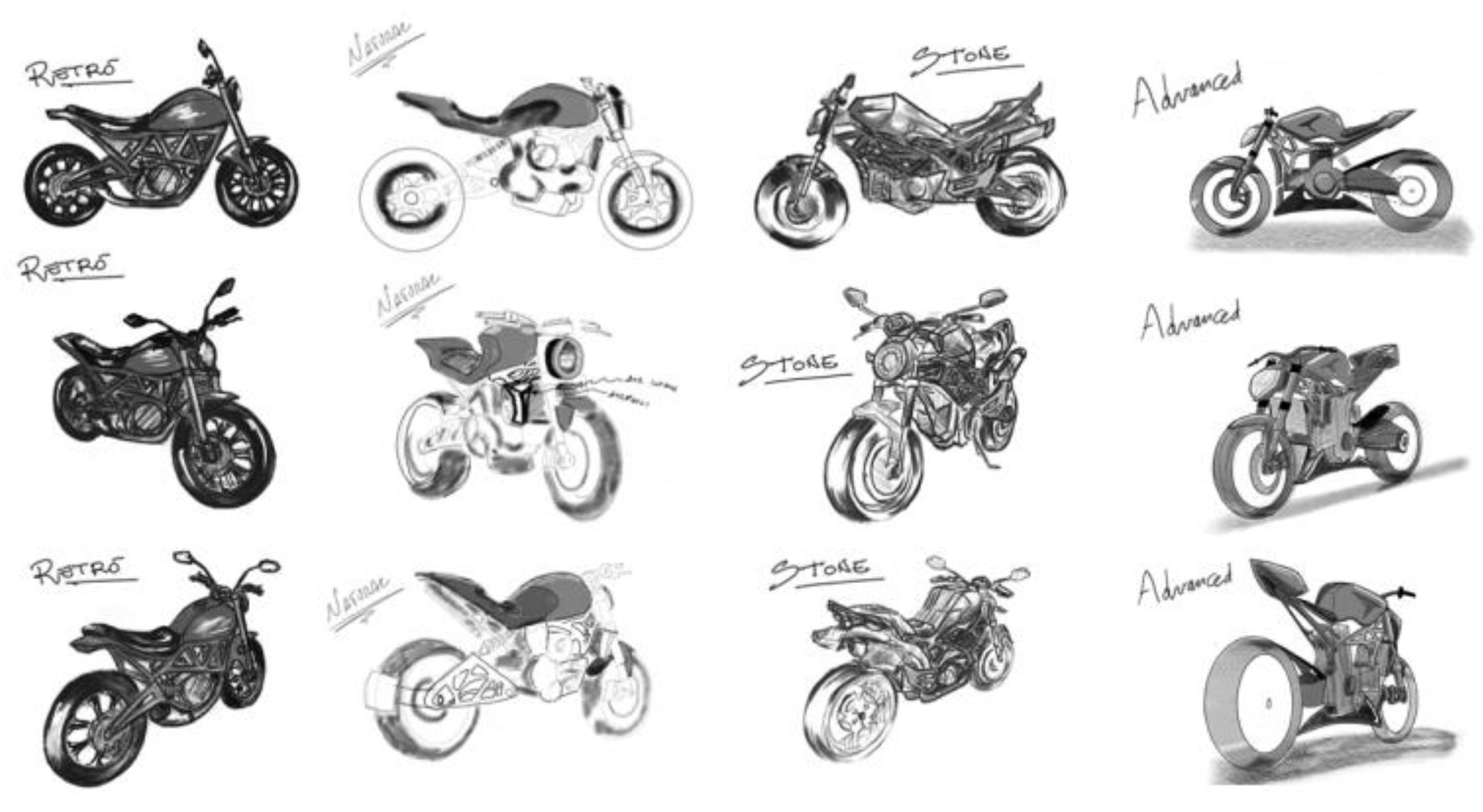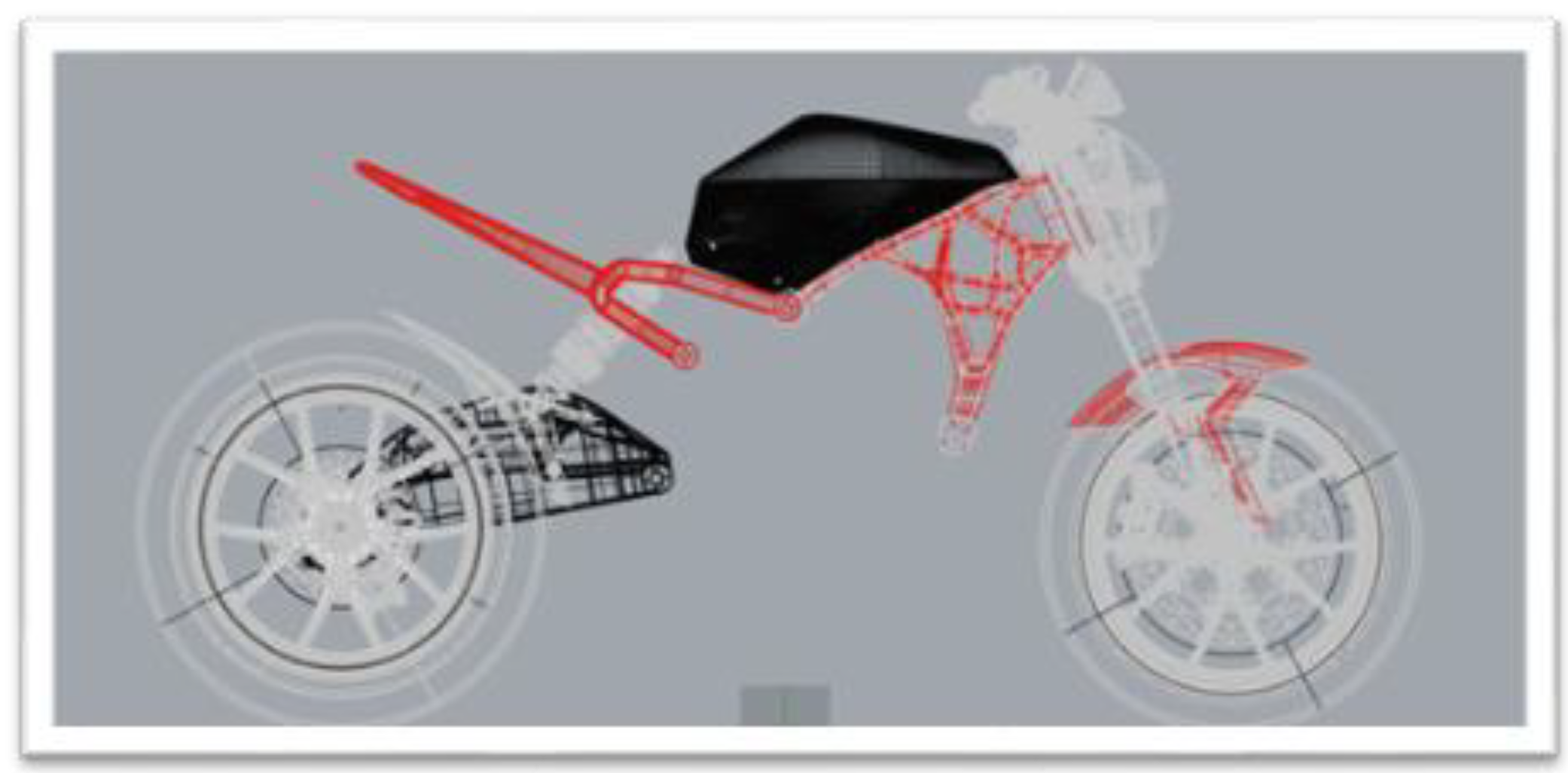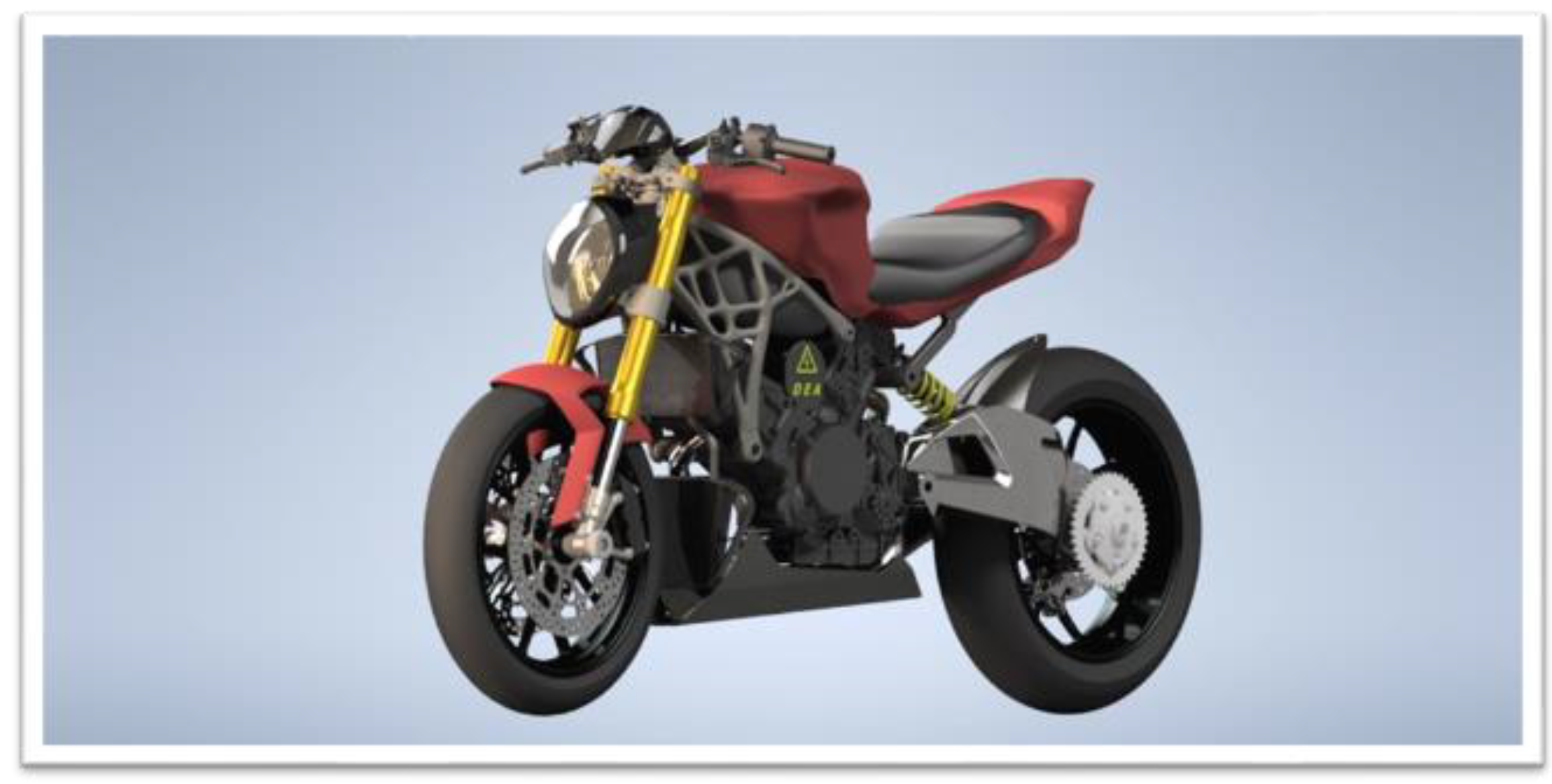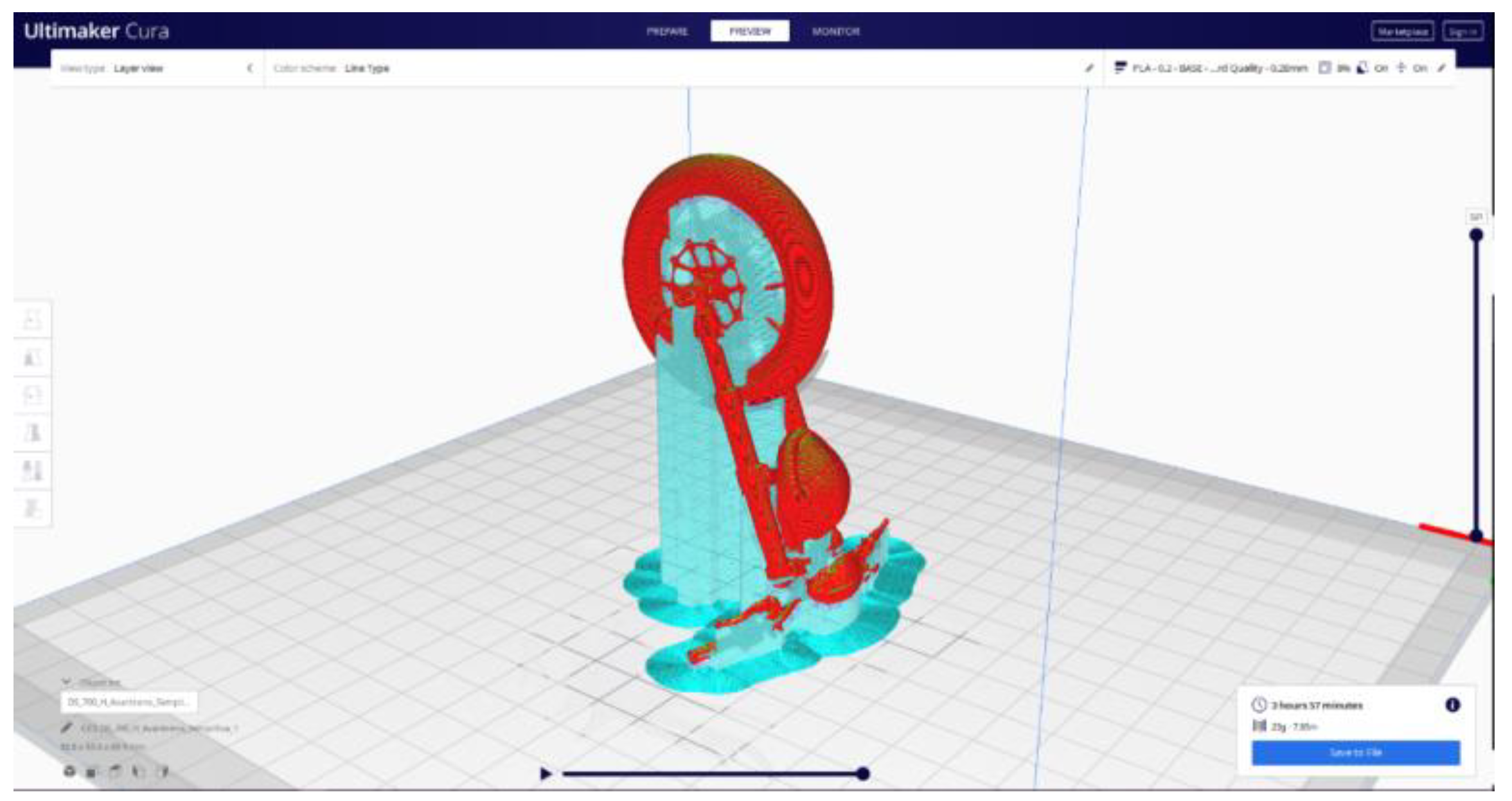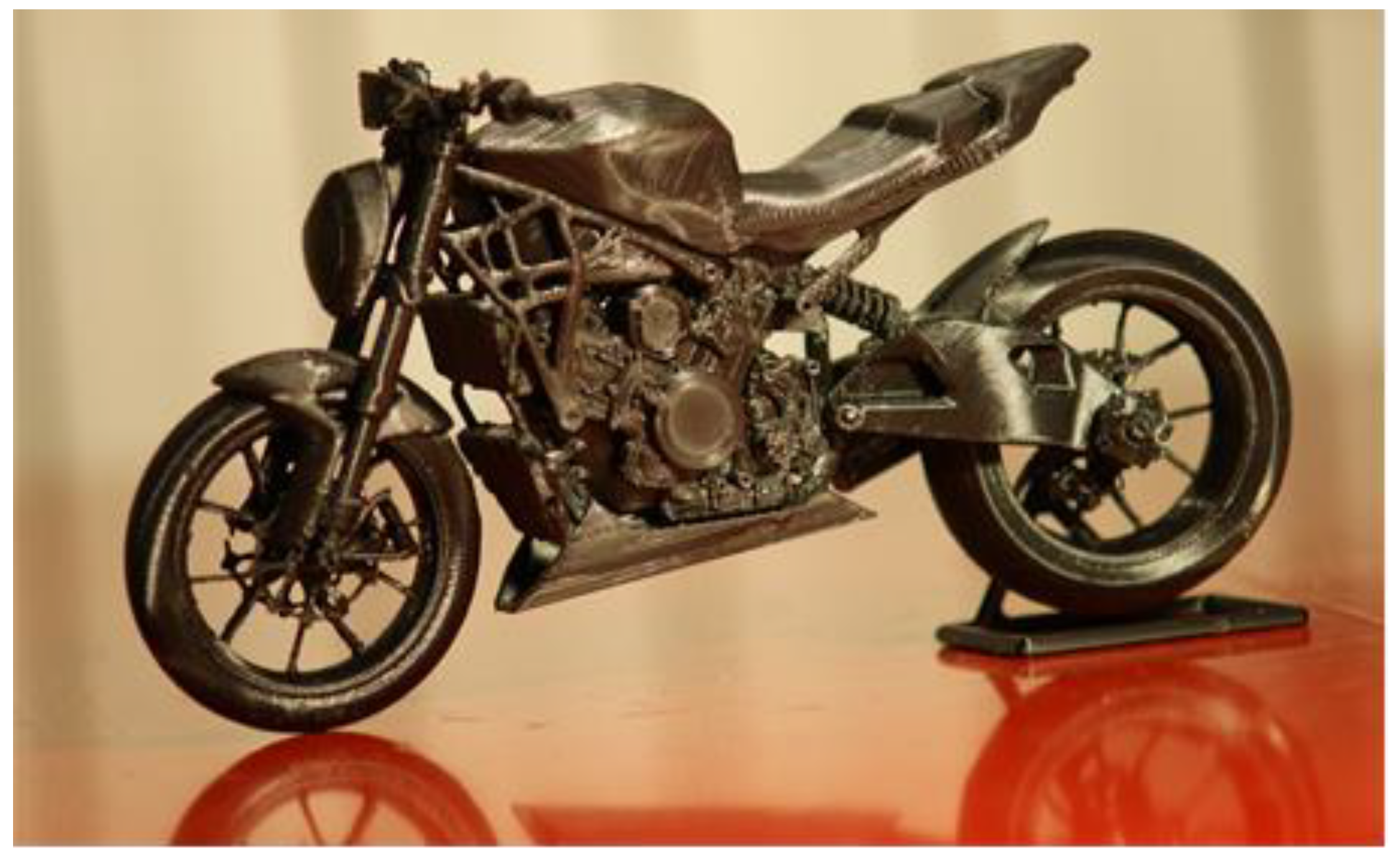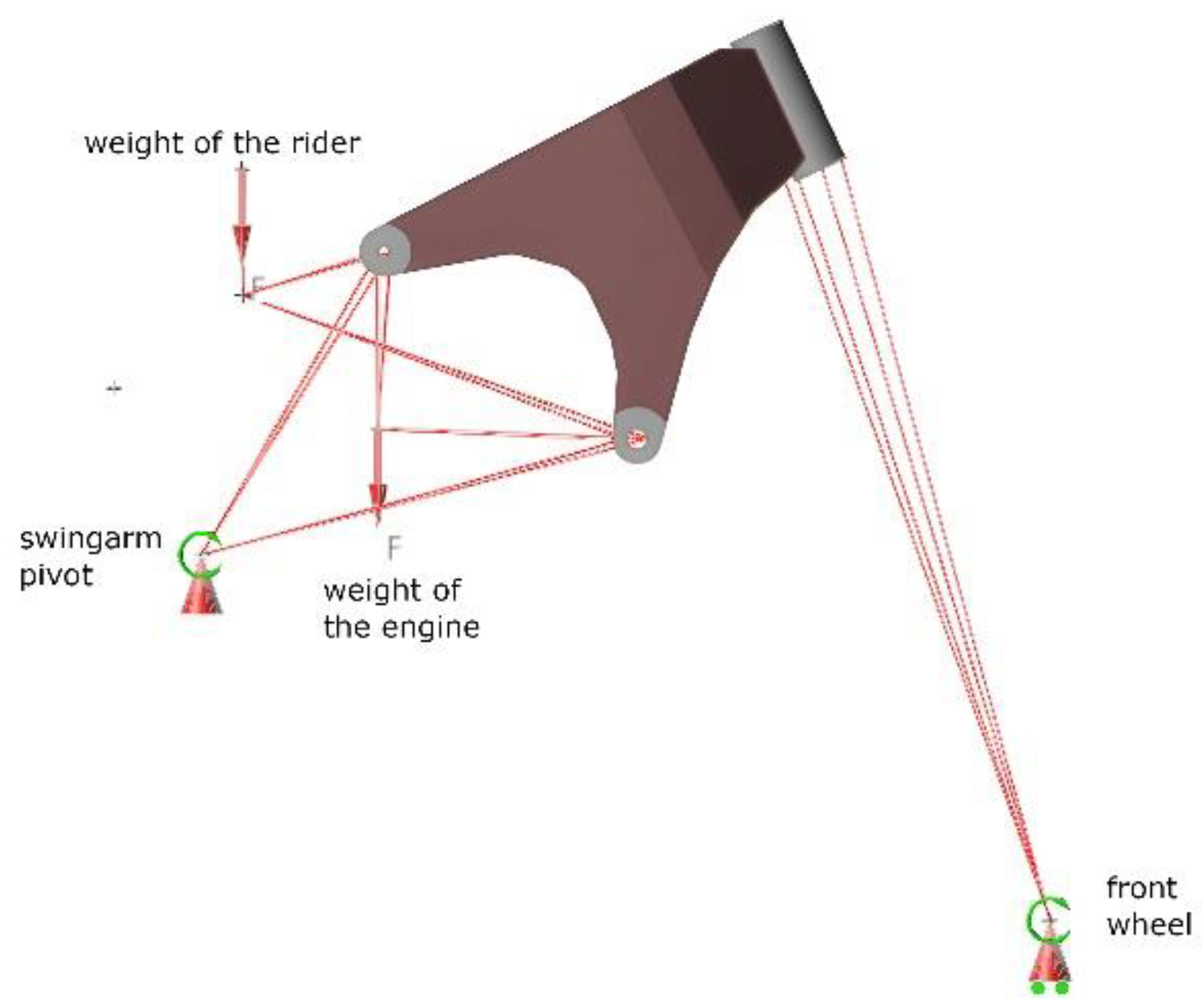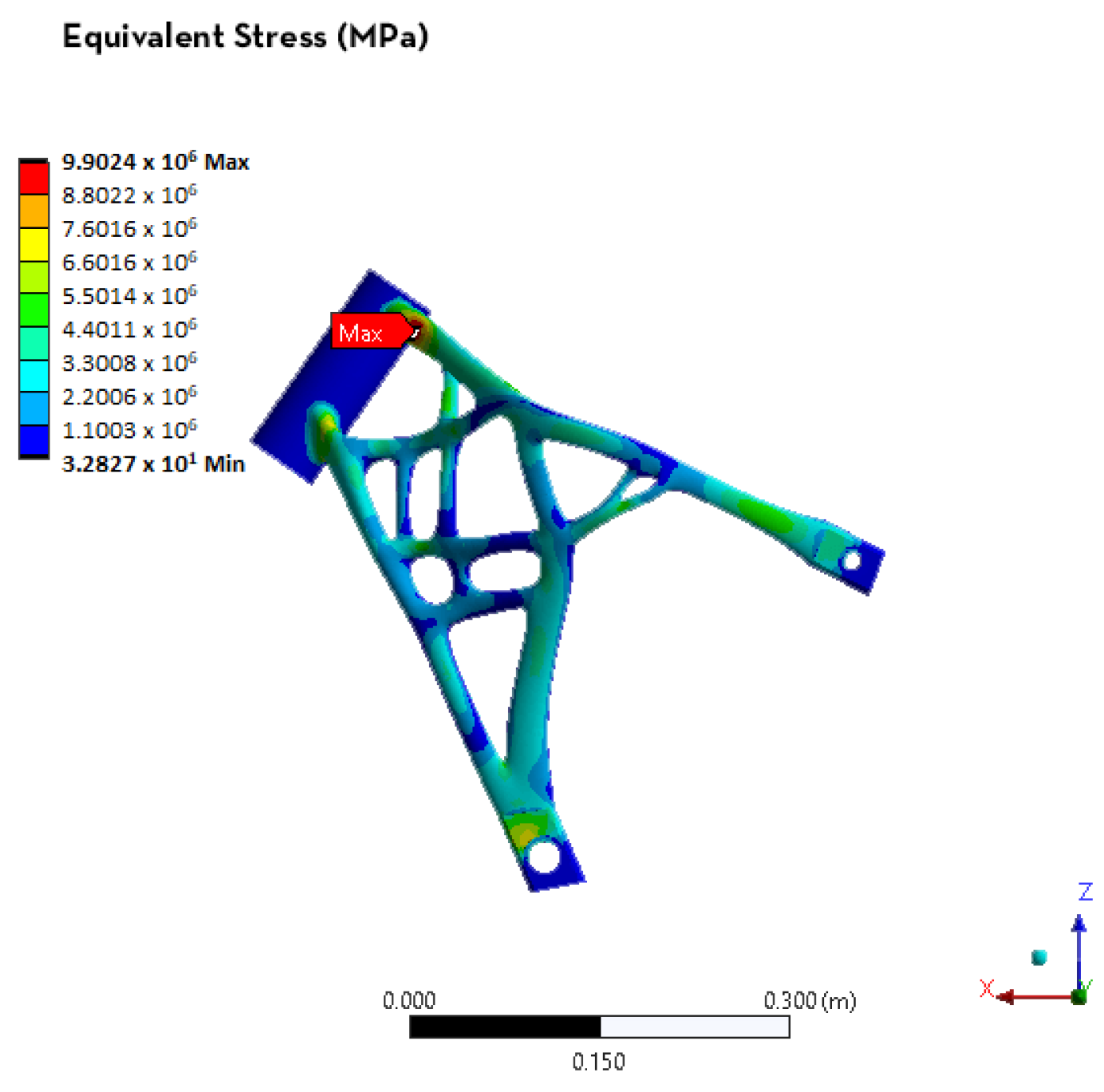1. Introduction
This project was born with the aim to create an innovative motor vehicle, highlighting innovative product design methods and competitive product characteristics that will guarantee a possible successful market share if put into production. Initial analysis led to the idea of solving the market’s need for an agile, innovative, and versatile two-wheeled vehicle, which could be used as a test bed for the future implementation of highly advanced features on production vehicles of such kind. All the various phases of creation and development of a transportation design product are analyzed, and the methods are shown and discussed.
The industrial design phase of a product has to pursue the design of each component, and to make a product attractive to the market it is necessary to carry out in-depth analyses and collect information directly from potential customers. To perform an accurate analysis and an innovative product development, it was chosen to apply the Industrial Design Structure (IDeS). Methodologies such as Quality Function Deployment (QFD) [
1] and Stylistic Design Engineering (SDE) were developed in the application of the transportation design project, and then applied to this design, and then the analysis and the detection of the unique innovation elements were made possible by the adoption of them. The development of an innovative industrial product is possible by subdividing the design process in phases. This allows a reduction in time and errors and consequently reduces the design costs. The use of innovative technologies, such as additive manufacturing (AM) and augmented reality (AR) shows the possibility of implementing the IDeS process rapidly and with extremely flexible solutions for virtual prototyping. Innovative ways to design the frame are also explored, studying the possibilities offered by topological optimization, and trying to incorporate these innovative technologies into the design to achieve real benefits in terms of performance and size.
To better achieve the goal of innovation in the design field, this project also used the SDE methodology. It is a design technique that has been successfully used in the industrial field and in the car design industry [
2]. It consists of the systematic arrangement of tasks gradually led by the design team, the labor of which becomes very rigorous and objective compliant, to obtain a model with the best possible characteristics and in full correspondence with the project targets set at the beginning of the work. This begins with the analysis of the style in the field of interest, up until the definition of the final model’s shape, through all the middle steps that allow precision and coherence in the design work [
3], also using innovative technologies such as rapid prototyping and augmented reality [
4] to better evaluate the lines and proportions of the model live and in a tangible way [
5].
The field of motorcycle design is of strong importance now as the motorcycle market has been a strong, growing market in the US [
6], especially because of the higher taxation, fuel prices, and running costs that represent having an affordable means of transport. In 2017 the motorcycle share of greenhouse gases in the Europe transport sector accounted for 0.9%, compared with 43.2% accountable to passenger vehicles and 18.7% to buses [
7]. Even though current market trends in the mobility sector are driven by sustainability [
8], switching swiftly towards electric-powered vehicles, electric motorcycles are likely to become more competitive than the ICE-sourced vehicles, especially due to the external impact costs such as particulate creation, climate change, and human toxicity [
9].
Furthermore, evolution on commercial simulation and parametric design software allows topology optimization algorithms on designed elements to be portrayed, modifying the structure by maintaining the smooth boundaries, and enabling engineers to modify the boundary information according to the given application [
10]. This process appears to be a compelling alternative for generating innovative designs [
11]. Various researchers have presented diverse topological design algorithms that can obtain smooth 3D topologies sourced from the volumetric, regular designed part. This approach has shown important results in construction [
12], as well as automotive [
13,
14], medical [
15], and additive manufacturing [
16] fields.
Therefore, this motorbike project has been developed with the goal of pursuing the path of innovation through all the design processes. The main objective is to develop an innovative motorbike, with advances focused on the chassis design and the engine proposal, as well as all the design set-up and analyses carried out. Various methodologies have been studied, strengthened, and adopted to achieve the target results. Methods such as QFD and SDE have been adopted in order to create a precise analysis and design of a coherent yet innovative project. Advanced design optimization techniques are applied such as topological optimization to explore innovative ways of structural optimization, and the final model is represented through virtual prototyping techniques.
2. Materials and Methods
The methodology chosen for this product development is IDeS, which aims to drive the whole organization structure in a development company by means of design, integrating both technical product and stylistic design, from which Stylistic Design Engineering (SDE) [
3,
5] was conceived. This methodology was first introduced by Lorenzo Ramacciotti, ex CEO of Pininfarina design house [
2], revealing a systematic style-oriented methodology to freeze style concepts in the world of car design [
17]. This method was picked by young designers and educators [
3,
18] as a tool to portray the best design solution.
Moreover, this solution combines innovative and logical product conception tools such as Quality Function Deployment (QFD), benchmarking, and top-flop analysis [
19], among others. The application of IDeS towards the present work can be structured in the following scheme, which summarizes the process involved (
Figure 1).
IDeS is a methodology that combines various planning and design techniques. For more accurate design, it is divided into technical and style design. Both have their specific tools and methodologies; in the development of this project the QFD and the SDE were used. Previous research by the authors demonstrated that IDeS is a tool that can help to portray a technical, market-oriented, and feasible prototype, and optimizes development time by means of straightforward information sharing across all departments during the development phases.
The first phases of this project consist of several steps, drawn in
Figure 2 for the development of the final model of this motorbike vehicle.
2.1. Environmental Analysis
Therefore, it is possible to see that the emotional value is extremely important [
20], as motorbike owners consider their bikes more than just a vehicle [
21]. As shown by many publications, the emotional involvement in the potential buyer of a motorcycle is high, and the most considered aspects in a customer’s product evaluation are: engine, media branding, price, advertising, and lastly fuel consumption [
22,
23].
Naked-Type Motorbikes
Naked bikes are a type of motorbike designed to have normal roads as their ideal environment. They differ from sport bikes in some key points. The first visible difference is the lack of fairings. The main purpose of them is to increase high speed efficiency, reducing the overall aerodynamic resistance, as sport bikes are designed with track performance as the main peculiarity. Due to their more road-oriented nature, naked bikes can get rid of this feature, lowering the total weight and exposing the mechanics, with an important stylistic effect. The high-speed performance and comfort are reduced, but that is not a problem for this type of bike. In fact, in order to make them more fun and comfortable on twisty roads, the whole ergonomics and gearing are adapted to agility rather than speed, so they do not need to reach compulsorily high speeds, as with their sports counterparts. Regarding the ergonomics, naked bikes generally have their foot controls set more in the center with a higher rising handlebar mounted on the bike’s triple tree. The placement of both the handlebars and the foot controls generally affect the stance of the rider and the bike’s overall silhouette. Because of the positioning of the motorcycle’s handlebars and foot controls, naked bikes generally have a more upright riding position. This gives them a more commanding view of the road ahead and allows them to be used with more comfort, especially on long rides. Bumps on the road are better dissipated by the bike’s suspension and the centered foot controls allow the legs to compensate for the additional shock on less worthy road conditions [
24].
As shown in
Figure 3, naked bikes can be divided into some categories based on style and performance: they can be more classic, sportive, or regular naked. One of the first modern naked bikes was considered the Ducati Monster, which made its debut in 1993. This bike has always been characterized by staying in step with the times and bringing innovative aspects to the market.
In 2021 a third of sold motorcycles in Italy were naked motorbikes, with overall sales growth of the sector of 21% [
25] (
Figure 4).
2.2. QFD
Moreover, IDeS method is applied to structure the planning and design phases by sharing information across departments (
Figure 1), and by the application of existing product design tools as QFD, SDE (
Figure 5).
To evaluate the best characteristics of an innovative product, it is necessary to study dependency relationships existing between the customer requirements. The QFD method was used to achieve this goal. This method makes use of matrices of interrelation, which provide the tools to create a unique ranking between the requirements. The first step is the individuation of these requirements through the use of six basic questions: who, what, where, when, why, and how. Having obtained all the requirements, it is then possible to move on to the interrelation matrices.
The analyses were carried out using the QFD method and the results of the design using the SDE are shown below. Moreover, the methods of QFD analysis used while carrying out this project were: the six questions, the relative importance matrix, the independence matrix, and the what–how matrix, in addition to the benchmark and the top-flop analysis. They are analyzed individually.
2.2.1. Six Questions and Customer Requirements
The six questions of the QFD were applied to the case study in the first design phase of our innovative naked motorcycle. The customer’s answers, which allow the requirements from analyses with the interrelation matrix to be found, are crucial in the next analyses. From the preceding analysis and the research carried out, key words are extrapolated for the product to be designed, which serve as a guideline in the subsequent matrix analysis and design phases.
Answers to the six question analysis made it possible to find some key words that were used to narrow the field in the next analyses:
WHO: Middle and Upper Class/Adult Riders
WHAT: Middle and Upper Class/Adult Riders
WHERE: Urban Roads/Suburban Roads/Motorways
WHEN: All Seasons/Different Weather
WHY: Fun/Personality/Performance/Versatility/Comfort
HOW: Everyday Life/Driving Experience/Safety
2.2.2. Independence Matrix
The independence matrix is built by placing all the customer requirement items, obtained from the six questions, both in column and in line. The goal is to determine the cause-and-effect relationships for each parameter by asking the question: how does the element on the row depend on the elements on the columns?
Numeric values, distinguishing between null link (empty box), weak (1), medium (3), or strong (9), are entered in the matrix to quantify the dependence relationship between each column and row element.
The independence matrix (
Figure 6) puts requirements found in the previous analysis into a scale of importance. The most important elements for the designer in the preliminary stages of design are summarized in the characteristics stated in the rows and columns of the chart. Then an interpolation of these features is performed based on the factual needs regarding the internal system and the final user, the values in the chart are identified through a scoring system agreed upon upstream of the analysis.
Therefore, the proper characteristics of rows and columns were identified after answering the six questions, which identified the most important characteristics to be used for this project.
2.2.3. Importance Matrix
While the construction is similar to the previous matrix, a different question is analyzed: is the element in the row more important than the element in the column?
As in the matrix described above, the numerical values are distinguished in:
- -
1: the row element and the column element have the same importance,
- -
0: the row element is less important than the column element,
- -
2: the row element is more important than the column element.
The importance matrix (
Figure 7) narrows the field even more to reach more precise innovative characteristics.
2.2.4. What–How Matrix
Through the what/how matrix, the customer’s requirements are compared with the technical requirements necessary for the realization of the product.
In this case numerical evaluations are used to identify the type of relationship:
- -
Nothing (empty box, equivalent to 0),
- -
Weak (1),
- -
Medium (3),
- -
Strong (9).
The what–how matrix (
Figure 8) is a very useful tool to understand the most influential spec that meets the requirements.
2.2.5. Benchmarking
To design an innovative naked motorbike, it is fundamental to analyze the models already existing on the market. Benchmarking is the process to study and systematically compare the various products and avoid subsequent change requests due to reprocessing or mistaken decisions made during the design process [
26].
Moreover, to have a clear idea of the competitors’ proposals, a benchmark analysis was carried out, comprising all the important characteristics of the products (
Figure 9). This arrived at the benchmark analysis table (
Figure 10) with the top flop analysis.
2.3. SDE
SDE is an innovative methodology widely used in car design field. This method consists of various steps to be carried out in sequence; the correct success of this sequence can lead to projects being consistent with both current market trends and history of the reference positioning brand.
The work begins with the study of stylistic trends [
3]. A large number of design mistakes are often due to a bad or insufficient study in the initial phases. The study takes into consideration the history of the car manufacturer of the car that is going to be designed. Aside from the history, the key moments of its path, positive and negative, and all the stages that have brought it to the present day are analyzed. Then comes the analysis of its stylistic past, identifying the key moments [
5].
Next step is freehand sketching. Thanks to the knowledge acquired in the previous phase, it is not difficult to trace forms consistent with the reference company and its style. Thus, the style and the personal trait of the designers are preserved and emphasized, they are guided by their research. In this way the sketches are not only beautiful to their taste, but significant for the project and the heritage of the brand. Different stylistic proposals are examined and modified, until arriving at a final selection [
5].
Then, the selected sketch is converted into a rigorous 2D computer drawing. This is an important step because in freehand sketches the shapes are often very “emotional” and out of proportion. This drawing technique, useful in the early stages, is inefficient when evaluating realistic shapes and proportions. In this way the appropriate changes can be made in the key areas, and the 2D drawing is updated [
5].
Based on 2D drawings, the creation of the 3D model is started. What usually happens is that the shapes of the model do not completely coincide with the 2D lines [
27], so the model is modified to meet the style requirements. At this point proportions are evaluated from every point of view, and the stylistic weaknesses are now visible and updated. The model is also detailed, the shapes gradually refined, and the style lines or the details of the bodywork are improved [
5].
Physical prototyping phase. Developed in
Section 2.6 (Physical Prototyping).
2.4. Structure Design
Afterwards, it was decided to proceed with a front-frame type for the frame design. The front frame itself allows reduced weight and dimensions compared to more conventional types of frames as it uses the engine as a stressed member, giving the overall bike increased rigidity and dynamic advantages. It has been widely used, for instance, in latest Ducati models, especially on trellis frame type. It is also found applied in motor racing competitions thanks to its dynamic advantages.
Topological Optimization
Moreover, the topological optimization of the front frame was performed. The term “topological optimization” defines the study, rearranges the distribution of material within the design domain, at different loads, and boundary conditions. This was carried out with new generation software that elaborates structural efficiency calculations [
28] in order to optimize overall structural performance and maintain factors of safety for overall and individual member instabilities [
29]. These iterations are able to redefine the shape of a mechanical component, allowing the model to be lightened through the subtraction of unnecessary material in order to maintain the properties of the piece while maintaining its mechanical performances [
30]. Research findings suggest the capability of portraying a computational homogeneous-based material calculation [
31], approach useful for multi-material topology optimization in vehicle frames for cross-section optimization [
32]. The main benefits of this approach are: reduce production costs, time and manufacturability efficiency [
33] by placing material where it is most appropriate, develop ideas that are unfeasible before the advent of these technologies, design parts in a completely different way that were previously designed rigidly due to constraints and limitations dictated by traditional production technologies. Applications in motorcycle design were found by [
34] that used the L9 orthogonal array in ANSYS 17.2 version to a sprocket design valuation. Lastly, the study by [
35] optimized the frame design of a motorbike by 26.63%.
2.5. Virtual Prototyping
Prototyping is a key aspect in the development of a project. Aside from physical prototyping, there is another type of method that can be used: this is virtual prototyping. Compared to its real counterpart, virtual prototyping has some peculiarities and important advantages, has been used in great-scale ambient mock-ups in maritime [
36], aircraft design [
37,
38], and even medical fields [
39]. In fact, while a real, physical model can be preferred to understand proportions and geometries of a model, it takes a lot of time and effort to make it look like the real model, for example, regarding materials and finishings. A virtual prototype, however, can substantially speed up the process, making it less expensive in terms of money and time used while maintaining a realistic look of the model. Making a virtual model with an appearance close to reality also helps when creating promotional multimedia, such as images or videoclips, or some views, such as exploded images of the models’ parts. For this project, two types of virtual prototyping were used: rendering and augmented reality. This technology is still evolving, and is becoming a novel mode of visualization and interaction supporting engineering design [
40,
41].
2.5.1. Rendering
Rendering refers to the creation of digital images of the product. It is a crucial part not only for the evaluation of the visual quality of the model, but also for the creation of communication images, crucial when showing the project to those who have not taken part in the project. With this technology it is possible to create images that represent the final aspect of the product, with full control of materials, colors, finish, roughness, reflections, and so on. In this way, through some steps, it is possible to create photorealistic images of any product with only a few hours of file set-up and calculation through a simple PC. It is also the phase of color and combination choices, and it makes possible to start to figure out how the product will look when put into production. It also allows to virtually recreate scenarios set in daily-use environments, and images for product presentations, advertisements, both photographic and in video form.
2.5.2. Augmented Reality
Augmented reality is another very powerful tool in the representation of the model. While with renderings it is possible to create photorealistic images, with AR technologies designers can visualize the 3D model of the product in the real world around them [
42]. Thus, it is possible to place the virtual model almost anywhere in the space and walk around it, seeing it through a smartphone, enhancing the design efficiency even more.
2.6. Physical Prototyping
Thanks to 3D modeling it is possible to have a realistic shape of the product. However, the monitor display has limitations, such as the correct display and definition of the curvature of the surfaces, and the always very difficult management of proportions, which in a product such as a car must be organic and harmonious from any view direction. To achieve this, a physical model of the project must be created. With a physical model realized, it is possible to correctly evaluate the quality of the surfaces and apply changes to the 3D model in the CAD. Sometimes it can be useful to realize a full-size model made from clay, a material widely used in automotive industry. It allows to bring modifications directly to the real model by hand, and, subsequently, via a 3D scan, import those changes into the virtual 3D model.
3. Results
3.1. SDE
3.1.1. Styling
A highly recognized Italian brand among the motorcycle sector was taken as a reference idea to portray the four main stylistic trends in SDE: Retrò, Stone, Natural, and Advanced. All the steps that have led to conceive the style among this Italian brand’s products until the present day were followed. The inspirational brand’s glorious history includes a reputation built thanks to the world of competitions, from which Ducati has always brought innovative technology and knowledge into their road models. The prestige of the Ducati brand was also built thanks to their unique engines, as real trademarks, thanks to the desmodromic distribution and unique character. These were the models analyzed to fully understand their characteristics and styling language:
125 Sport (1957)
Scrambler 450 (1968)
750 GT (1972)
500 SL Pantah (1979)
851 S (1987)
Monster 900 (1993)
916 (1994)
3.1.2. Sketching
A proposal inspired by each of the four stylistic trends was created (
Figure 11), and then a stakeholder meeting was held in order to agree on the choice of characteristics to portray the final proposal, as seen in
Figure 12.
RETRO: rounded simple lines, presence of round or oval components, reference to features of past models.
NATURAL: essential curves, general cleanliness, lightness, reference to elements present in nature.
STONE: large and clear lines, square and angular volumes, feeling of solidity and heaviness.
ADVANCED: attractive design, light and shadow on surfaces, bold but light lines, combination of unique surfaces and visible edges.
3.1.3. CAD Design Engineering
The first step of the development was to rework and transform the sketches into rigorous 2D drawings (
Figure 13). As a result, compared to the sketches, it was possible to have a clear overview of the different designs, making it easier to notice the possible weaknesses.
An integral part of the project was the ergonomic research to make the product close to the needs of the pilot. The narrow seat from the natural sketch was inspired by competitions, as was the deep shell on the frame for the knees taken from the advanced sketch to ensure maximum adherence of the body to the bike for better control. These features helped to reduce the fatigue of the upper body; the masses to be managed were brought to a minimum, and the maximum visibility of the road was always guaranteed. The final design was then obtained by combining the results of all the analyses listed above and the suggestions provided by motorcycle engineers during the various seminars.
Moreover, by using PTC CREO and Autodesk Inventor, it was possible to create and assemble the first 3D mock-up, which was the first step to further develop our design (
Figure 14 and
Figure 15).
Starting from the mock-up, it was possible to create the 3D surfaces’ structure using Rhinoceros as it allows a good degree of freedom and control when creating surfaces (
Figure 16).
The surfaces were than imported into the Inventor model to continue their development and assemble all the finished components. Having assembled our final 3D model, the chance was now taken to study its aerodynamic performance.
3.1.4. Rendering
Thereafter, the model was imported on Autodesk’s VRED software, which gives the possibility of realizing high quality renderings and animations. This software allowed the design to be reproduced and placed in a realistic environment (
Figure 17).
3.1.5. Prototyping
Having a prototype of the object you want to produce allows several preventive tests to be conducted, i.e., to verify its ergonomics, functionality, assembly, and aesthetics. Three-dimensional prototypes in plastic molding projects therefore have several advantages: they reduce the design cycle, and, consequently, any additional expenses that facilitate the testing of the shape, size, and assembly and help in the development and correct definition of the product.
A realistic prototype is also a very effective tool for marketing actions and can be useful to all the different business areas to provide a more concrete vision of the project: from R&D, to the technical office, to marketing, and to production.
The DS700H took advantage of the possibility to use 3D printing to evaluate the shape and the fittings of the parts. Once the 3D model was completed, it was subdivided into printable assemblies to be first sliced in CURA software, printed, and finally joined together with glue (
Figure 18).
The model was printed in a CREALITY ENDER 3 (CORDOL TECHNOLOGY, Hong Kong, China), which is a desktop machine for hobby purposes, using a height of 0.2 mm and touching build-plate supports to ensure that the material had volume to stick on (
Figure 19).
3.1.6. Augmented Reality
The software used to add our bike to the everyday environment is Unity, an engine for video game development that allows video games to be created and exported to multiple platforms. It consists of a graphics engine, a physical engine, and a live game preview that allows the changes made during the programming phase to be viewed in real time.
The AR technology used is marker based, therefore following the recognition of an object in two or three dimensions that, framed by an appropriate viewer, places the virtual object in its spatial position (
Figure 20).
To achieve augmented reality through the use of the marker, it is necessary to use an additional package of Unity, called Vuforia. Vuforia is a software development kit for AR applications that can provide fast and accurate image tracking. The main part of the package consists of the Image Target, the tracker that analyzes every single frame captured by the camera to check if it contains fragments of known images—trackable—and to which specific behaviors are associated. Another fundamental component is the AR Camera, a component used to identify the marker, acting as a video camera within the program and connecting with the real world thanks to the devices used for augmented reality.
3.2. Frame Technical Assessment
In order to give some brand identity to this model, a reference was made to the Ducati brand, and it was decided to use the trellis frame to sum up the trademark and for the aesthetic factor that follows. For this reason, the design began by considering the dimensions and geometry of a trellis frame on which a desmodromic engine was mounted, with a caster angle of 25°; a value obtained from the benchmark and considered plausible for an agile and responsive bike. Furthermore, the geometry obtained was imported into the Altair Inspire software on which topological optimization was carried out considering two load cases: static, i.e., the weight of the rider and the engine, with a hinge constraint on the swingarm pivot and a bogie on the front wheel; and at limit braking: considering the braking forces on the front wheel (
Figure 21).
The chosen material was the aluminum alloy AlSi 10 Mg, characterized by a yield stress of 250 MPa and an average density of 2.67 g/cm
3 [
43]. The topological optimization was performed by imposing a “mass minimization” approach considering the two load cases and trying to respect a safety coefficient of 2. The resulting geometry was then modelled using Altair Inspire. The final result had a total mass of 4 kg, which is considered satisfactory compared to the nearly 8 kg of a trellis frame.
Moreover, to comply with the ideal geometry obtained, it was decided to use Selective Laser Melting (SLM) additive technology in order to obtain a frame that came as close as possible to the mechanical properties predicted by the software at the design stage. With a view to future-oriented production, the decision to use an aluminum frame rather than a carbon fiber frame (which had been evaluated in the preliminary phase) was also intended to have a “greener” production objective. In addition, it made it possible to achieve a better futuristic look that still managed to maintain references to the Ducati trellis frame. Finally, there was a reduction in material waste since the project switched from a trellis frame that usually weighs 9 kg to a model with a weight of 4 kg, maintaining the same overall dimensions.
Afterwards, the entire model was imported into the ANSYS software to validate the geometry obtained. This software is versatile for the number of calculations that can be used for assessments so that engineers can reach the target values [
44]. The geometry was slightly modified by eliminating fittings and chamfers that were not necessary for the FEM analysis and, in order to reduce the number of elements, only half the frame was simulated by imposing a symmetry constraint on the software. The mesh used was 3 mm with tetrahedra 3D elements. The two static linear analyses of the two load cases were carried out: static and limit braking overturning. The weight of the engine was 700 N and the weight of the rider was 900 N, so a limit breaking scenario in
X and
Z axes was applied with 2913 N and 2700 N, respectively. In the static case, the performance was considered sufficient with a maximum deformation of 0.14 mm and an equivalent stress of 10 MPa (
Figure 22).
At the braking limit, the performance was not considered sufficient due to the high stress at certain points (
Figure 23), which brought the safety coefficient close to 1. After analyzing the most stressed points, the geometry of the frame was modified at the attachments to the steering head (
Figure 24).
Thanks to this solution, the maximum deformation decreased by two-tenths of a mm to 1.85 mm, while the Von Mises stress decreased by 61 MPa to 170 MPa without a significant increase in the weight in the structure. This result was considered satisfactory.
4. Discussion
The project succeeded in achieving its objectives. In particular, through the methods of Stylistic Design Engineering (SDE) and Quality Function Deployment (QFD) it was possible to conduct the stylistic development of a futuristic naked motorbike. It managed to improve the design phase thanks to the prototyping solutions adopted, as these permitted us to potentially avoid the induction of a subsequent redesign phase that would generate higher costs for the total management of the project. Afterwards, different real-world scenario analyses were developed thanks to augmented reality and additive manufacturing. These gave us the opportunity to help develop both the styling and the technical side of the product. To further develop the project, in order to make it closer and closer to production, more aspects need to be investigated, such as some of the main innovations of the bike that need standalone projects. Starting with the powertrain, a hybrid proposal was developed with the idea of downsizing the engine to 700cc (compared to the benchmarking competitors) and recovering the loss of power of the small displacement with an electric engine, providing torque to increase riding pleasure, which would receive energy in deceleration phases. Although the idea was taken from an already existing project and the electric motor respected the dimensions of a 7–10 kW unit, further dimensioning of the supercap capacity and positioning to give the maximum efficiency need to be performed.
Regarding the presence of power electronics, it is possible to develop FEM simulations about electromagnetic fields to study interference (e.g., using Altair Flux). Furthermore, to give the rider the best experience possible, dynamic simulation and modelling need to be performed in environments capable of modelling a preliminary control system for the hybrid powertrain.
Regarding the active aerodynamics that conceptually equip servo motors to change the angle of attack of the wing, further CAD modelling and dimensioning of the motor must be performed. Additionally, more complex CFD analysis that can confirm or deny the advantages of such a solution are necessary; in fact, the solution was chosen by looking at the other bikes on the market (such as MV Agusta Brutale 1000 RR for the winglets design, Ducati Streetfighter V4 for their position, and Moto Guzzi V100 Mandello for the possibility to equip active aerodynamics), but specific solutions need to be developed for this DS700H.
Another sensible feature is the additive manufactured frame: although the solution is already possible, the usage of such technology for series production remains an unexplored field, but as the technology grows continuously, it must not only be taken into account for the realization of prototypes. In the meantime, further investigations on the fatigue resistance of a component such as the frame are mandatory.
5. Conclusions
This design-inspired project, helped by the application of the IDeS method, was able to achieve the following results.
A precise and straight product target analysis, which held to a straightforward problem definition, was sourced from customer’s needs, assessing potential design challenges, and benefitting from the technological opportunities that were found, allowing time and money to be saved, not only on the analysis itself, but also in the design and redesign phases where important savings were made. This also allowed the concept of topological optimization to be applied in order to conceive a lightweight structure that eventually led to an engineering, as well as a stylish, optimum proposal.
A quick and coherent design phase development of the concept set-up and study was performed by means of the SDE method that led to the style and technical feasibility of the final model in a fast and secure way, avoiding potential delays in change requests that could have compromised the overall quality of the design and with respect to the time schedule.
A secure final check to control the quality of the proposal, thanks to the augmented reality, rendering, and prototyping design validation phases that helped to straightforwardly freeze the design of the product. These methodologies also made it possible to keep timelines under control during all phases of processing, and to keep down the risk of an overall lengthening of the project development timelines.
Author Contributions
Conceptualization, L.F. and L.I.; methodology, L.F.; software, L.L.; validation, S.M., P.P. and L.L.; formal analysis, C.L.-C. and G.A.; investigation, L.I. and C.L.-C.; resources, L.L., S.M., P.P. and L.I.; data curation, G.G.; writing—original draft preparation, G.G. and C.L.-C.; writing—review and editing, G.G. and C.L.-C.; visualization, L.L. and G.G.; supervision, L.F.; project administration, L.F.; funding acquisition, L.F. All authors have read and agreed to the published version of the manuscript.
Funding
This research received no external funding.
Conflicts of Interest
The authors declare no conflict of interest.
References
- Ginting, R.; Ishak, A.; Fauzi Malik, A.; Satrio, M.R. Product Development with Quality Function Deployment (QFD): A Literature Review. IOP Conf. Ser. Mater. Sci. Eng. 2020, 1003, 012022. [Google Scholar] [CrossRef]
- Donnici, G.; Frizziero, L.; Liverani, A.; Buscaroli, G.; Raimondo, L.; Saponaro, E.; Venditti, G. A New Car Concept Developed with Stylistic Design Engineering (SDE). Inventions 2020, 5, 30. [Google Scholar] [CrossRef]
- Frizziero, L.; Donnici, G.; Francia, D.; Caligiana, G.; Gaddoni, A. Stylistic Design Engineering (SDE) for an Innovative Green Vehicle Following QFD and Triz Applications. Int. J. Mech. Prod. Eng. Res. Dev. 2019, 9, 805–827. [Google Scholar] [CrossRef]
- Freitas, G.; Pinho, M.S.; Silveira, M.S.; Maurer, F. A Systematic Review of Rapid Prototyping Tools for Augmented Reality. In Proceedings of the 2020 22nd Symposium on Virtual and Augmented Reality (SVR), IEEE, Porto de Galinhas, Brazil, 7–10 November 2020; pp. 199–209. [Google Scholar]
- Donnici, G.; Frizziero, L.; Liverani, A.; Galiè, G.; Lelli, F. A New SUV Conceived by Stylistic Design Engineering (SDE). In Proceedings of the International Conference on Industrial Engineering and Operations Management, Bangkok, Thailand, 5–7 March 2019; pp. 2125–2142. [Google Scholar]
- Zhang, T.; Burke, P.J. Fuel Prices and Road Deaths: Motorcyclists Are Different. Accid. Anal. Prev. 2021, 162, 106396. [Google Scholar] [CrossRef] [PubMed]
- Danielis, R.; Scorrano, M.; Giansoldati, M. Decarbonising Transport in Europe: Trends, Goals, Policies and Passenger Car Scenarios. Res. Transp. Econ. 2021, 91, 101068. [Google Scholar] [CrossRef]
- Cadavid, L.; Salazar-Serna, K. Mapping the Research Landscape for the Motorcycle Market Policies: Sustainability as a Trend—A Systematic Literature Review. Sustainability 2021, 13, 10813. [Google Scholar] [CrossRef]
- Carranza, G.; Do Nascimiento, M.; Fanals, J.; Febrer, J.; Valderrama, C. Life Cycle Assessment and Economic Analysis of the Electric Motorcycle in the City of Barcelona and the Impact on Air Pollution. Sci. Total Environ. 2022, 821, 153419. [Google Scholar] [CrossRef] [PubMed]
- Fu, Y.-F.; Rolfe, B.; Chiu, L.N.S.; Wang, Y.; Huang, X.; Ghabraie, K. SEMDOT: Smooth-Edged Material Distribution for Optimizing Topology Algorithm. Adv. Eng. Softw. 2020, 150, 102921. [Google Scholar] [CrossRef]
- Fu, Y.-F.; Rolfe, B.; Chiu, L.N.S.; Wang, Y.; Huang, X.; Ghabraie, K. Smooth Topological Design of 3D Continuum Structures Using Elemental Volume Fractions. Comput. Struct. 2020, 231, 106213. [Google Scholar] [CrossRef]
- Goli, A.; Alaghmandan, M.; Barazandeh, F. Parametric Structural Topology Optimization of High-Rise Buildings Considering Wind and Gravity Loads. J. Archit. Eng. 2021, 27, 4021038. [Google Scholar] [CrossRef]
- Yıldız, A.R.; Kılıçarpa, U.A.; Demirci, E.; Doğan, M. Topography and Topology Optimization of Diesel Engine Components for Light-Weight Design in the Automotive Industry. Mater. Test. 2019, 61, 27–34. [Google Scholar] [CrossRef]
- Dalpadulo, E.; Pini, F.; Leali, F. Systematic Integration of Topology Optimization Techniques in Design for Additive Manufacturing Methodologies Applied to Automotive Settings. In Proceedings of the ASME International Mechanical Engineering Congress and Exposition; American Society of Mechanical Engineers: New York, NY, USA, 2020; Volume 84539, p. V006T06A016. [Google Scholar]
- Abass, R.S.; Al, A.M.; Al, A.M. Shape and Topology Optimization Design for Total Hip Joint Implant. In Proceedings of the World Congress on Engineering, London, UK, 3–5 July 2019. [Google Scholar]
- Ribeiro, T.P.; Bernardo, L.F.A.; Andrade, J.M.A. Topology Optimisation in Structural Steel Design for Additive Manufacturing. Appl. Sci. 2021, 11, 2112. [Google Scholar] [CrossRef]
- Verganti, R. Innovazione, Design e Management. Strategie e Politiche per Il Sistema-Piemonte; Politecnic, Associazione Torino Internazionale: Torino, Italy, 2008. [Google Scholar]
- Canestraro, N. The Impact of Design Thinking on Education: The Case of Active Learning Lab; Università Ca’Foscari Venezia: Venice, Italy, 2017. [Google Scholar]
- Frizziero, L.; Donnici, G.; Dhaimini, K.; Liverani, A.; Caligiana, G. Advanced Design Applied to an Original Multi-Purpose Ventilator Achievable by Additive Manufacturing. Appl. Sci. 2018, 8, 2635. [Google Scholar] [CrossRef] [Green Version]
- Nugroho, M.A.; Harjanto, R. Consumer Tribalism in Buying Decision Role. In Proceedings of the Ninth International Conference on Entrepreneurship and Business Management (ICEBM 2020), Online, 19 November 2020; Atlantis Press: Dordrecht, The Netherlands, 2021; pp. 525–530. [Google Scholar]
- Ahlers, T.J. The Impact of Emotions on Consumer Decision-Making: A Consumer Behaviour Analysis of Hedonic Consumption as Related to the Harley-Davidson Brand. Ph.D. Thesis, Queen Margaret University, Edinburgh, UK, 2019. [Google Scholar]
- Harsono, S.; Perdana, S.; Riyadi, D.B. The Influence of Brand Image, Brand Trust, Perceived Quality and Perceived Value on Consumer Purchase Intention at Different Categories of Product. Adv. Sci. Lett. 2018, 24, 3198–3207. [Google Scholar] [CrossRef]
- Afiatin, Y.; Djajanto, L. Assessing the Pricing Persceptives of Motorcycle Product Attributes on Customer Behavior. Int. J. Financ. Bank. Stud. 2022, 11, 46–52. [Google Scholar]
- MotoDeal Naked vs. Sportbikes—What’s the Difference? Available online: https://www.motodeal.com.ph/articles/motorcycle-features/naked-vs-sportbikes-whats-difference (accessed on 24 February 2022).
- GPone Mercato Moto e Scooter 2021, Anno Da Record: +21.2%. Available online: https://www.gpone.com/it/2022/01/05/moto-news/mercato-moto-e-scooter-2021-anno-da-record-212.html (accessed on 24 February 2022).
- Piancastelli, L.; Frizziero, L.; Donnici, G. Learning by Failures: The “Astura II” Concept Car Design Process. ARPN J. Eng. Appl. Sci. 2014, 9, 2009–2015. [Google Scholar]
- Tabib, M.; Rasheed, A.; Siddiqui, M.S.; Kvamsdal, T. A Full-Scale 3D Vs 2.5 D Vs 2D Analysis of Flow Pattern and Forces for an Industrial-Scale 5MW NREL Reference Wind-Turbine. Energy Procedia. 2017, 137, 477–486. [Google Scholar] [CrossRef]
- Piancastelli, L.; Frizziero, L.; Bombardi, T. Bézier Based Shape Parameterization in High Speed Mandrel Design. Int. J. Heat Technol. 2014, 32, 57–63. [Google Scholar]
- Changizi, N.; Jalalpour, M. Topology Optimization of Steel Frame Structures with Constraints on Overall and Individual Member Instabilities. Finite Elem. Anal. Des. 2018, 141, 119–134. [Google Scholar] [CrossRef]
- Gholizadeh, S.; Ebadijalal, M. Performance Based Discrete Topology Optimization of Steel Braced Frames by a New Metaheuristic. Adv. Eng. Softw. 2018, 123, 77–92. [Google Scholar] [CrossRef]
- Larsen, S.D.; Sigmund, O.; Groen, J.P. Optimal Truss and Frame Design from Projected Homogenization-Based Topology Optimization. Struct. Multidiscip. Optim. 2018, 57, 1461–1474. [Google Scholar] [CrossRef] [Green Version]
- Lu, S.; Ma, H.; Xin, L.; Zuo, W. Lightweight Design of Bus Frames from Multi-Material Topology Optimization to Cross-Sectional Size Optimization. Eng. Optim. 2019, 51, 961–977. [Google Scholar] [CrossRef]
- Valm, N.; Changizi, N.; Tootkaboni, M.; Asadpoure, A. Topology Optimization of Imperfect Frame Structures with Improved Manufacturability. Int. J. Mech. Sci. 2022, 213, 106869. [Google Scholar] [CrossRef]
- Barua, A.; Bagal, D.K.; Jeet, S.; Pradhan, S.; Patnaik, D.; Pattanaik, A.K. Virtual Design Optimization of Motorbike Rear Sprocket Based on ANSYS and Hybrid MOORA-Fuzzy Inference System. In Lecture Notes in Mechanical Engineering; Springer: Berlin/Heidelberg, Germany, 2021; pp. 481–495. ISBN 9789811598524. [Google Scholar]
- Ahmed, S.; Gupta, M.K. Investigations on Motorbike Frame Material and Comparative Analysis Using Generative Design and Topology Optimization. Mater. Today Proc. 2021, 56, 1440–1446. [Google Scholar] [CrossRef]
- Chu, Y.; Hatledal, L.I.; Zhang, H.; Æsøy, V.; Ehlers, S. Virtual Prototyping for Maritime Crane Design and Operations. J. Mar. Sci. Technol. 2018, 23, 754–766. [Google Scholar] [CrossRef]
- Jian, F.U.; Jean-Charles, M.; Liming, Y.U.; Yongling, F.U. Multi-Level Virtual Prototyping of Electromechanical Actuation System for More Electric Aircraft. Chinese J. Aeronaut. 2018, 31, 892–913. [Google Scholar]
- Skjong, S.; Rindarøy, M.; Kyllingstad, L.T.; Æsøy, V.; Pedersen, E. Virtual Prototyping of Maritime Systems and Operations: Applications of Distributed Co-Simulations. J. Mar. Sci. Technol. 2018, 23, 835–853. [Google Scholar] [CrossRef] [Green Version]
- Bilancia, P.; Berselli, G. Conceptual Design and Virtual Prototyping of a Wearable Upper Limb Exoskeleton for Assisted Operations. Int. J. Interact. Des. Manuf. 2021, 15, 525–539. [Google Scholar] [CrossRef]
- Wolfartsberger, J. Analyzing the Potential of Virtual Reality for Engineering Design Review. Autom. Constr. 2019, 104, 27–37. [Google Scholar] [CrossRef]
- Horvat, N.; Škec, S.; Martinec, T.; Lukačević, F.; Perišić, M.M. Comparing Virtual Reality and Desktop Interface for Reviewing 3D CAD Models. In Proceedings of the Design Society: International Conference on Engineering Design, Delft, The Netherlands, 1 July 2019; Cambridge University Press: Cambridge, UK, 2019; Volume 1, pp. 1923–1932. [Google Scholar]
- Boboc, R.G.; Gîrbacia, F.; Butilă, E.V. The Application of Augmented Reality in the Automotive Industry: A Systematic Literature Review. Appl. Sci. 2020, 10, 4259. [Google Scholar] [CrossRef]
- EOS. EOS Aluminum AlSi10Mg. Available online: https://www.eos.info/en/additive-manufacturing/3d-printing-metal/dmls-metal-materials/aluminium-al (accessed on 25 January 2022).
- Frizziero, L.; Rocchi, I.; Donnici, G.; Pezzuti, E. Aircraft Diesel Engine Turbocompound Optimized. JP J. Heat Mass Transf. 2015, 11, 133–150. [Google Scholar] [CrossRef]
Figure 1.
The IDeS general structure.
Figure 1.
The IDeS general structure.
Figure 2.
The path of the designing phases.
Figure 2.
The path of the designing phases.
Figure 3.
Different types of naked motorbikes.
Figure 3.
Different types of naked motorbikes.
Figure 4.
Motorcycle registrations by segment in Italy for the year 2021.
Figure 4.
Motorcycle registrations by segment in Italy for the year 2021.
Figure 5.
The IDeS methods for project conception.
Figure 5.
The IDeS methods for project conception.
Figure 6.
Independence Matrix.
Figure 6.
Independence Matrix.
Figure 7.
Importance Matrix.
Figure 7.
Importance Matrix.
Figure 8.
What–how matrix.
Figure 8.
What–how matrix.
Figure 9.
Competitors selected for the benchmark analysis.
Figure 9.
Competitors selected for the benchmark analysis.
Figure 10.
Benchmark and top-flop analysis.
Figure 10.
Benchmark and top-flop analysis.
Figure 11.
Various sketches with proposals following the four main styles trends.
Figure 11.
Various sketches with proposals following the four main styles trends.
Figure 12.
The selected proposal.
Figure 12.
The selected proposal.
Figure 13.
Two-dimensional CAD drawing of the stone proposal.
Figure 13.
Two-dimensional CAD drawing of the stone proposal.
Figure 14.
Three-dimensional model of the selected proposal.
Figure 14.
Three-dimensional model of the selected proposal.
Figure 15.
Side view of 3D model.
Figure 15.
Side view of 3D model.
Figure 16.
Finished model with all surfaces.
Figure 16.
Finished model with all surfaces.
Figure 17.
Final renderings of the developed model.
Figure 17.
Final renderings of the developed model.
Figure 18.
Preparation of the 3D printing.
Figure 18.
Preparation of the 3D printing.
Figure 19.
Finished 3D printed model.
Figure 19.
Finished 3D printed model.
Figure 20.
Three-dimensional model in augmented reality environment.
Figure 20.
Three-dimensional model in augmented reality environment.
Figure 21.
Topological optimization set-up.
Figure 21.
Topological optimization set-up.
Figure 22.
Static load—equivalent stress FEM simulation—max deformation = 0.14 mm.
Figure 22.
Static load—equivalent stress FEM simulation—max deformation = 0.14 mm.
Figure 23.
Limit brake—equivalent stress FEM simulation—max deformation = 1.85 mm.
Figure 23.
Limit brake—equivalent stress FEM simulation—max deformation = 1.85 mm.
Figure 24.
Modifications on the frame.
Figure 24.
Modifications on the frame.
| Publisher’s Note: MDPI stays neutral with regard to jurisdictional claims in published maps and institutional affiliations. |
© 2022 by the authors. Licensee MDPI, Basel, Switzerland. This article is an open access article distributed under the terms and conditions of the Creative Commons Attribution (CC BY) license (https://creativecommons.org/licenses/by/4.0/).
